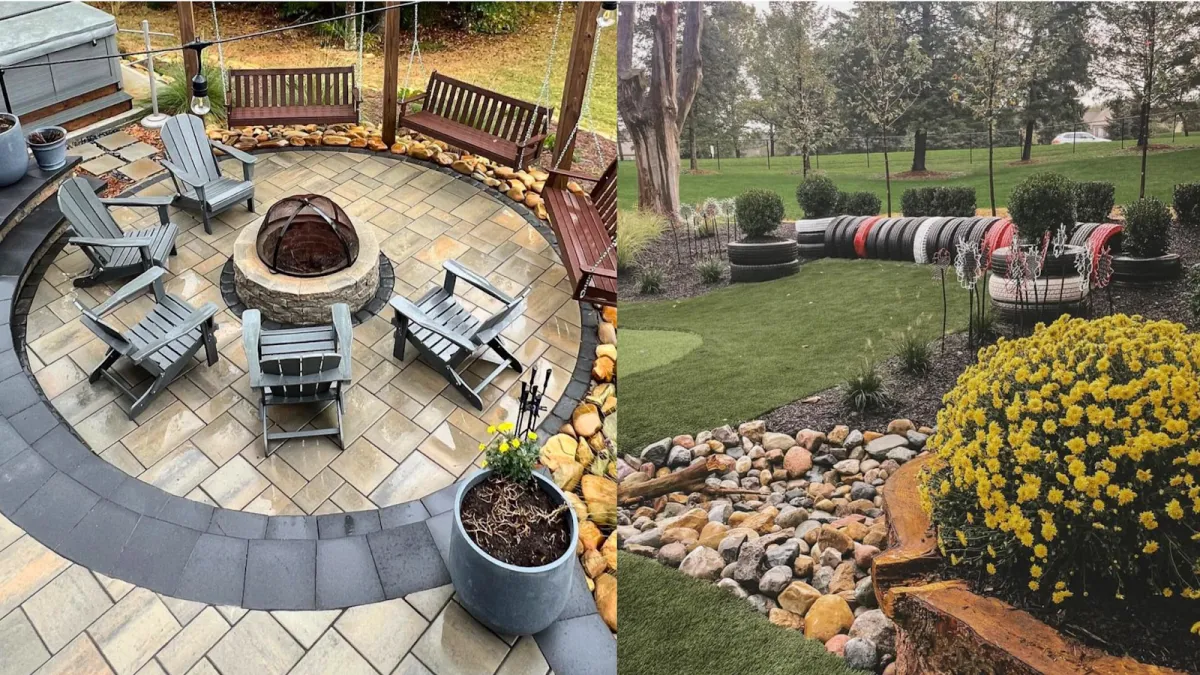Blogs

What's The Difference Between Softscaping And Hardscaping?
Softscaping refers to the living elements of landscaping, such as plants, trees, flowers, and soil. It includes the use of vegetation to enhance the aesthetics and functionality of outdoor spaces.
Hardscaping, on the other hand, refers to the non-living, man-made elements of landscaping, such as pathways, walls, patios, decks, and fences. It involves the use of hard materials like concrete, stone, wood, and metal to define and structure the outdoor environment.
Landscaping is a vital aspect of creating an inviting and functional outdoor space. Whether you want to enhance your home's curb appeal or create a backyard oasis, understanding the elements of landscaping is crucial. At Greystone Hardscapes, we specialize in transforming outdoor living dreams into reality. Based in the greater Charlotte, North Carolina area, we pride ourselves on providing top-notch service and craftsmanship. Today, we're checking into the difference between softscaping and hardscaping, two fundamental components of any landscape design.
Key Takeaways:
Softscaping includes living elements like plants and flowers, while hardscaping involves non-living structures like patios and pathways.
A balanced landscape combines both elements to create a functional and beautiful outdoor space.
Regular maintenance is essential for both softscaping and hardscaping to ensure longevity and aesthetic appeal.
Current trends highlight sustainability in softscaping and versatility in hardscaping.
What is Softscaping?
Softscaping refers to the living, growing elements of a landscape. This includes everything from trees and shrubs to flowers, grass, and other plants. Softscaping brings color, texture, and life to your outdoor space. Imagine the lush greenery of a well-manicured lawn, the vibrant hues of blooming flowers, or the soothing rustle of leaves in the breeze. These are all aspects of softscaping.
The primary benefits of softscaping include its ability to improve air quality, provide shade, and create a natural habitat for wildlife. Moreover, softscaping can enhance the aesthetic appeal of your property, making it more inviting and enjoyable.
What is Hardscaping?
Hardscaping, on the other hand, encompasses the non-living, structural elements of a landscape. This includes pathways, patios, decking, fencing, retaining walls, and more. Hardscaping forms the foundation of your outdoor space, providing organization and functionality. Picture a sturdy stone pathway leading to a cozy patio, or a well-constructed retaining wall adding dimension to your garden—these are examples of hardscaping.
The benefits of hardscaping are numerous. It offers durability and permanence, often requiring less maintenance than its living counterparts. Hardscaping also plays a critical role in defining the layout and usability of your outdoor areas, making them more accessible and enjoyable.
Key Differences Between Softscaping and Hardscaping
While both softscaping and hardscaping are essential to landscape design, they differ significantly in their nature and maintenance. Softscaping consists of living elements that require ongoing care, such as watering, fertilizing, and pruning. These elements are dynamic and change with the seasons, offering a continually evolving landscape.
Hardscaping, however, involves non-living elements that, once installed, remain relatively constant. Maintenance for hardscaping typically involves cleaning, sealing, and minor repairs, making it a more permanent solution.
In terms of design, softscaping provides the beauty and life of a garden, while hardscaping provides the structure and functionality. A well-designed landscape balances both elements to create an aesthetically pleasing and functional outdoor space.
The Importance of Balance in Landscaping
Creating a harmonious outdoor space requires a careful balance of softscaping and hardscaping. This balance ensures that your landscape is not only beautiful but also functional and sustainable. Softscaping brings natural beauty and environmental benefits, while hardscaping adds durability and practicality.
For instance, combining a vibrant garden with a sturdy patio creates a space where you can enjoy nature comfortably. Similarly, incorporating pathways and retaining walls can enhance the usability and aesthetic of your garden, making it both inviting and organized.
Design Considerations for Softscaping
When planning your softscape, consider the climate and soil conditions of your area. Choosing plants that are well-suited to your environment will ensure they thrive and require less maintenance. Additionally, think about plant placement and how different species will interact. Consider seasonal changes and select plants that offer year-round interest, providing a dynamic and colorful landscape.
Design Considerations for Hardscaping
Hardscaping requires careful consideration of materials and structural integrity. Whether you choose stone, concrete, wood, or metal, ensure the materials complement your home's architecture and existing landscape features. Safety is also a priority; make sure pathways are even and retaining walls are structurally sound.
Integration is key in hardscape design. Hardscaping elements should seamlessly blend with the softscape to create a cohesive and inviting outdoor space. For example, a stone pathway winding through a garden can add charm and accessibility.
Softscaping Maintenance Tips
Maintaining your softscape involves regular watering, fertilizing, pruning, and pest control. Establish a routine to keep your plants healthy and vibrant. Use mulch to retain soil moisture and control weeds. Regularly inspect your plants for signs of disease or pests, and take appropriate action to protect your garden.
Hardscaping Maintenance Tips
Hardscaping maintenance focuses on preserving the integrity and appearance of non-living elements. Clean and seal surfaces to protect them from weather damage. Repair any cracks or damage promptly to prevent further deterioration. Use weed barriers to keep unwanted plants from growing between pavers or stones.
Popular Softscaping Trends
In recent years, trends in softscaping have shifted towards sustainability and environmental consciousness. Native plants and sustainable gardening practices are gaining popularity as they require less water and maintenance. Pollinator gardens, designed to attract bees, butterflies, and other beneficial insects, are also on the rise. Additionally, edible landscaping, which incorporates fruit and vegetable plants into ornamental gardens, offers both beauty and bounty.
Popular Hardscaping Trends
Hardscaping trends are evolving towards creating versatile and stylish outdoor living spaces. Modern minimalist designs with clean lines and simple materials are in vogue. Multi-functional hardscape features, such as fire pits that double as seating or retaining walls that serve as garden beds, are also popular. These trends reflect a desire for outdoor spaces that are both beautiful and practical.
Choosing the Right Professionals
Hiring experienced landscapers is crucial for achieving a well-balanced landscape. When selecting a contractor, ask about their experience, portfolio, and approach to balancing softscaping and hardscaping. At Greystone Hardscapes, we pride ourselves on our expertise and dedication to quality. Our team works closely with clients to create landscapes that enhance their lifestyle and property.
How Can I Balance Hardscaping And Softscaping In My Garden
Balancing hardscaping and softscaping in your garden is essential to create a harmonious and visually appealing outdoor space that also serves functional purposes. Here’s how you can achieve this:
Start with a Comprehensive Plan
Begin by assessing your garden’s layout and envisioning how both hardscaping and softscaping elements can complement each other. A well-thought-out plan will help you allocate space efficiently and ensure a cohesive design.
Define Zones
Divide your garden into distinct zones for different purposes, such as entertaining, relaxing, and gardening. Use hardscaping features like pathways, patios, and decks to delineate these zones while incorporating softscaping elements to soften the edges and add natural beauty.
Choose Complementary Materials
Select hardscaping materials that harmonize with the architecture of your home and the overall theme of your garden. For instance, if your house has a rustic charm, consider using natural stone for pathways or retaining walls. Blend these materials with softscaping elements like native plants and flowering shrubs to create a balanced aesthetic.
Focus on Scale and Proportion
Ensure that the size and scale of both hardscaping and softscaping elements are proportional to the size of your garden. Avoid overwhelming smaller spaces with large structures and plants. Instead, opt for compact hardscape features like small garden beds or potted plants that complement the area.
Integrate Water and Lighting Features
Enhance the ambiance of your garden by incorporating water features such as fountains or ponds, which add a soothing element amidst the plants and structures. Additionally, strategically placed outdoor lighting can highlight both hardscaping and softscaping elements, extending the usability of your garden into the evening hours.
Consider Maintenance Requirements
Understand the upkeep needs of both hardscaping and softscaping elements. Softscaping typically requires regular watering, pruning, and fertilizing, while hardscaping may need occasional cleaning, sealing, or repair. Choose plants and materials that fit your maintenance schedule and lifestyle to ensure long-term enjoyment of your garden.
Seek Professional Advice
Consulting with a landscaping professional, such as Greystone Hardscapes, can provide valuable insights and expertise in balancing hardscaping and softscaping. They can offer personalized recommendations based on your garden’s unique characteristics and your preferences, ensuring a well-balanced and sustainable outdoor environment.
FAQs
What is the cost difference between softscaping and hardscaping?
The cost of softscaping is generally lower than hardscaping, as plants and soil are less expensive than materials like stone and concrete. However, ongoing maintenance costs for softscaping can add up over time.
Can I DIY my landscaping project?
While small projects can be DIY-friendly, larger and more complex landscaping projects are best handled by professionals to ensure quality and durability.
How do I choose the right plants for my softscape?
Consider your climate, soil type, and the amount of sunlight your garden receives. Native plants are often a good choice as they are adapted to local conditions and require less maintenance.
What are the most durable hardscaping materials?
Stone and concrete are among the most durable hardscaping materials, offering longevity and low maintenance. Metal and treated wood are also durable options for certain applications.
How often should I maintain my hardscaping features?
Regular inspections and cleaning are recommended. Depending on the material, sealing every few years and repairing any damage promptly will help maintain the integrity of your hardscaping features.
Transform Your Outdoor Oasis: Expert Landscaping with Greystone Hardscapes
Balancing softscaping and hardscaping is essential for creating a beautiful and functional outdoor space. By combining the natural beauty of plants with the durability of structures, you can achieve a harmonious landscape that enhances your home. At Greystone Hardscapes, we're dedicated to helping you create the perfect outdoor living environment.
Contact us now for a consultation and let our expert team bring your landscaping dreams to life. Whether you need a stunning garden, a functional patio, or a complete landscape makeover, we've got you covered. Reach out to us today and take the first step towards creating your perfect outdoor oasis!
You Dream It.
We Build It.
Superiror Craftmanship.
Every Time.
Hardscape Services:
Copyright © Greystone Hardscapes Inc. 2024. All Rights Reserved. Privacy Policy. Terms & Conditions. Web Design by Fused Media

